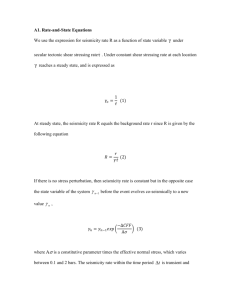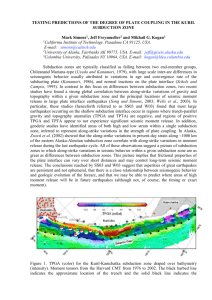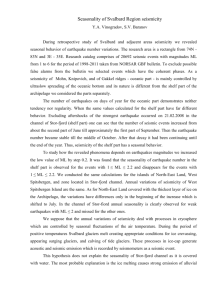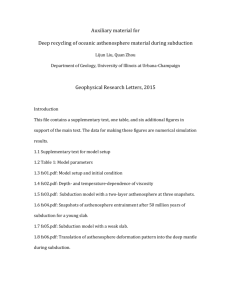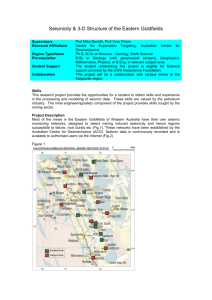ABW1 - COST Action ES0801
advertisement
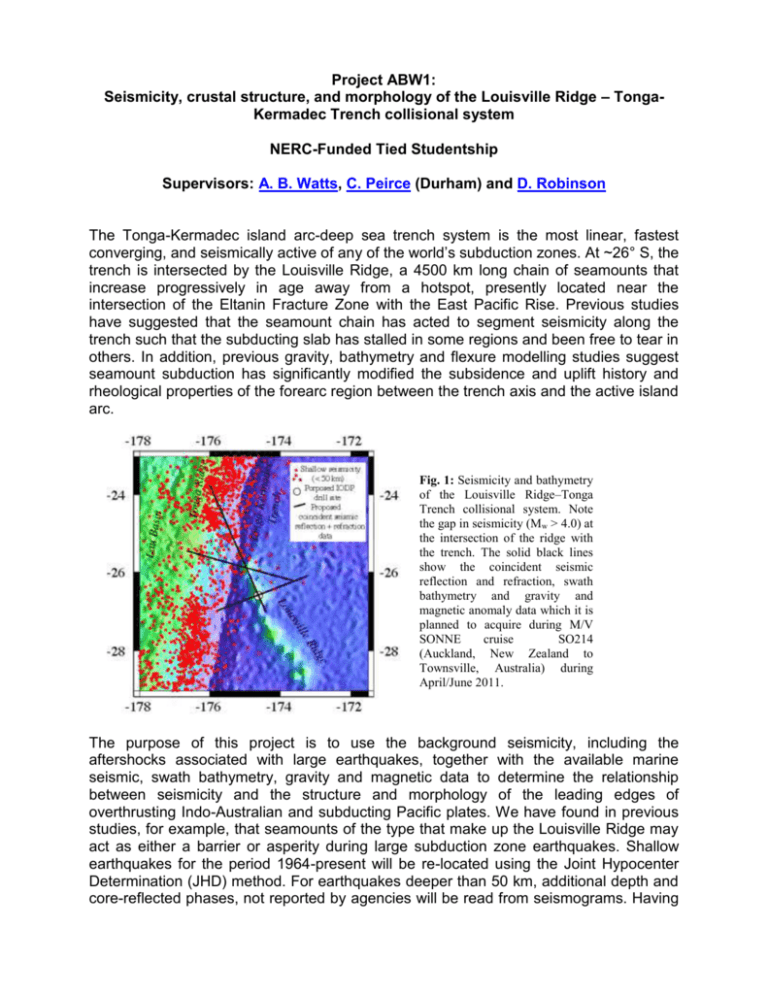
Project ABW1: Seismicity, crustal structure, and morphology of the Louisville Ridge – TongaKermadec Trench collisional system NERC-Funded Tied Studentship Supervisors: A. B. Watts, C. Peirce (Durham) and D. Robinson The Tonga-Kermadec island arc-deep sea trench system is the most linear, fastest converging, and seismically active of any of the world’s subduction zones. At ~26° S, the trench is intersected by the Louisville Ridge, a 4500 km long chain of seamounts that increase progressively in age away from a hotspot, presently located near the intersection of the Eltanin Fracture Zone with the East Pacific Rise. Previous studies have suggested that the seamount chain has acted to segment seismicity along the trench such that the subducting slab has stalled in some regions and been free to tear in others. In addition, previous gravity, bathymetry and flexure modelling studies suggest seamount subduction has significantly modified the subsidence and uplift history and rheological properties of the forearc region between the trench axis and the active island arc. Fig. 1: Seismicity and bathymetry of the Louisville Ridge–Tonga Trench collisional system. Note the gap in seismicity (Mw > 4.0) at the intersection of the ridge with the trench. The solid black lines show the coincident seismic reflection and refraction, swath bathymetry and gravity and magnetic anomaly data which it is planned to acquire during M/V SONNE cruise SO214 (Auckland, New Zealand to Townsville, Australia) during April/June 2011. The purpose of this project is to use the background seismicity, including the aftershocks associated with large earthquakes, together with the available marine seismic, swath bathymetry, gravity and magnetic data to determine the relationship between seismicity and the structure and morphology of the leading edges of overthrusting Indo-Australian and subducting Pacific plates. We have found in previous studies, for example, that seamounts of the type that make up the Louisville Ridge may act as either a barrier or asperity during large subduction zone earthquakes. Shallow earthquakes for the period 1964-present will be re-located using the Joint Hypocenter Determination (JHD) method. For earthquakes deeper than 50 km, additional depth and core-reflected phases, not reported by agencies will be read from seismograms. Having determined the seismicity, links will then be made to the structure and morphology of the subduction zone. The principal data sets here will be marine seismic reflection and refraction, swath bathymetry and gravity and magnetic anomaly data that were acquired during a German funded cruise of M/V SONNE in January/February 2008 and a planned NERC-funded cruise, also onboard SONNE, that is presently scheduled for April/June 2011. Of particular interest is the region of the Louisville gap (e.g. Fig. 1) where there maybe seamounts, ahead of the Louisville Ridge, that have either been obducted more or less in tact or carried down into the subduction channel and decapitated by plate motions. The student will participate in all aspects of the proposed work (including the 2011 SONNE cruise) and will receive training in the location of earthquakes, the acquisition, reduction and interpretation of marine geophysical data and, seismic, gravity and flexure modeling. Selected references: Cloos, M., and R. L. Shreve (1996), Shear-zone thickness and the seismicity of Chileanand Marianas-type subduction zones, Geology, 24, 107-110. Das, S., and A. B. Watts (2009), Effect of subducting seafloor topography on the rupture characteristics of great subduction zone earthquakes, in Subduction Zone Geodynamics, edited by S. Lallemand and F. Funiceillo, pp. 103-118, Springer-Verlag, Berlin-Heidelberg. Das, S., and B. V. Kostrov (1990), Inversion for seismic slip rate and distribution with stabilising constraints: Application to the 1986 Andreanof Islands earthquake, J Geophys. Res., 95, 6899-6913. Dewey, J. F. 1971, Seismic studies with the method of joint hypocenter determination, PhD. thesis, Univ. Calif. Berkley. Hillier, J. K., and A. B. Watts (2007), Global distribution of seamounts from ship-track bathymetry data, Geophys. Res. Letts., 34, doi:10.1029/2007GL029874. PDF Koppers, A. A. P., R. A. Duncan, and B. Steinberger (2004), Implications of a nonlinear 40Ar/39Ar age progression along the Louisville seamount trail for models of fixed and moving hot spots, Geochemistry Geophysics Geosystems, 5, do:10.1029/2003GC000671. Robinson, D. P., S. Das, and A. B. Watts (2006), Earthquake rupture stalled by a subducting fracture zone, Science, 312, 1203-1205. PDF Scholz, C. H., and C. Small (1997), The effect of seamount subduction on seismic coupling, Geology, 25, 487-490. Watts, A. B., and M. Talwani (1975), Gravity effect of downgoing lithospheric slabs beneath island arcs, Geol. Soc. Amer. Bull, 86, 1-4. Watts, A. B., J. K. Weissel, R. A. Duncan, and R. L. Larson (1988), Origin of the Louisville Ridge and its relationship to the Eltanin Fracture Zone system, J. Geophys. Res., 93, 3051-3077. PDF Watts, A. B., D. T. Sandwell, W. H. F. Smith, and P. Wessel (2006), Global gravity, bathymetry, and the distribution of submarine volcanism through space and time, J, Geophys. Res., 111, doi:10.1029/2005JB004083. PDF

